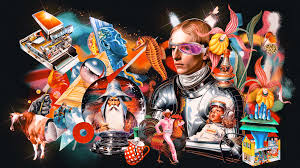
Digital collage has emerged as one of the most dynamic and versatile art forms of the 21st century. By blending photography, illustration, textures, and typography, artists create layered visuals that tell complex stories. Unlike traditional collage, which requires physical cut-and-paste techniques, digital tools allow for infinite experimentation without damaging the original materials.
The popularity of digital collage has exploded thanks to easy access to software like Photoshop, Procreate, and AI-based design tools. Artists can seamlessly mix vintage photographs with futuristic graphics, merging eras and styles in a single frame. This flexibility has attracted not only visual artists but also musicians, fashion brands, and filmmakers who use collages for album covers, campaign visuals, and promotional materials.
One of the key strengths of digital collage is its ability to blend cultures and ideas. A single work might combine Indian folk motifs, Japanese patterns, and contemporary typography, reflecting our interconnected world. The medium also thrives on social media, where its bold and surreal compositions grab attention instantly.
Far from replacing traditional art, digital collage is expanding its boundaries, allowing artists to explore limitless creative possibilities. It stands as a visual language for the digital age—rich, experimental, and deeply expressive.
